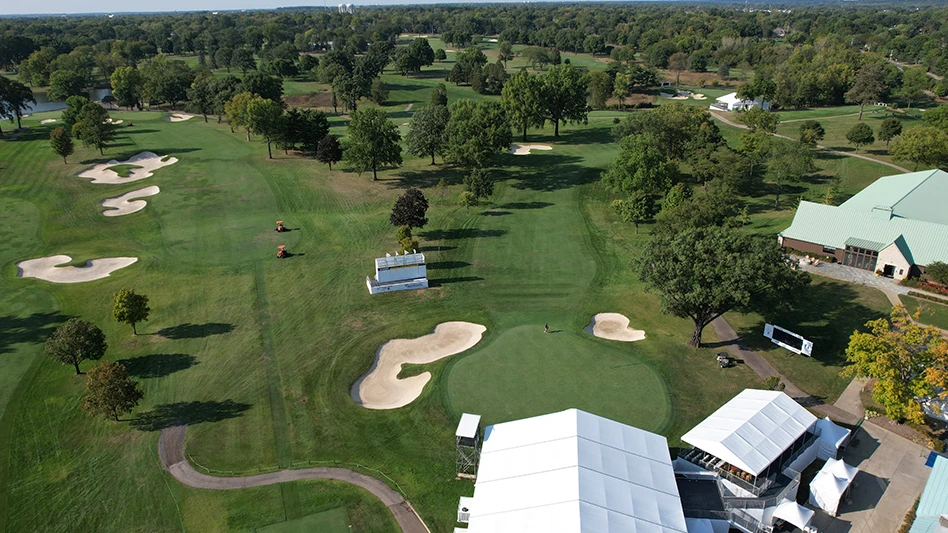
Tim Connelly
According to the National Integrated Drought Information System, 87.7 percent of Ohio is in a drought, 23.2 percent is in extreme drought conditions and 28.6 percent is in a severe drought. August 2024 recorded the 26th driest August on record since 1895 and 8.3 million Ohio residents are living in an area with drought conditions.
The Ohio Department of Natural Resources has asked Ohioans to use water carefully and preserve where they can. But how does this impact a golf course, where acres upon acres are reliant upon water and irrigation? For Firestone Country Club director of golf course operations Larry Napora, it reveals the deficiencies.
“When you have weather like this, you find your irrigation weaknesses,” Napora says. “You have to learn your property and know what your irrigation limits are, and you have to figure it out. It's challenging.”
 The Firestone Country Club North Course in the middle of a dry September stretch. (Kelsie Horner)
The Firestone Country Club North Course in the middle of a dry September stretch. (Kelsie Horner)
For the 54-hole club, a less-than-updated irrigation system is in place. Unlike many clubs, a wall-to-wall irrigation system is not used. Water used for maintenance comes from an on-property lake, but with the recent drought conditions, mud can frequently make its way into the sprinkler system causing blockages.
USGA Green Section Central Regional director Zach Nicoludis has traveled the Midwest and observed direct impacts from the dry weather. Nicoludis, like Napora, emphasizes that less water exposes weaknesses in irrigation systems.
The drought weather has initiated conversations in the industry regarding updating watering systems and conservation. “We anticipate more discussions coming up around it,” Nicoludis says. “We continue to talk about this a lot in the field, and highlight it in our reports, as well as even in our research.”
Numerous golf courses are using irrigation systems beyond their life cycle. “This really highlights for a lot of golf courses why they need a new irrigation system,” Nicoludis says. “Not just from the coverage standpoint, but you’re out there running the system more, so you’re putting more strain on it, probably seeing more leaks develop so you’re having to do more repairs and maintenance.”
The drought conditions also illustrate staffing issues in the industry for Napora. Less rain means more hand watering, and when September hits, students go back to school and maintenance team numbers decrease. Napora’s team focuses on tees, greens and fairways. They keep the greens as fast and firm as possible. Roughs are the areas most affected by the dry weather. “When you have a wet year, everything’s green and you kind of slide by, life’s good,” Napora says. When a dry spot is found on the course, Napora must determine if it is due to lack of water, insect infestation or turf disease.
For Ohio State University Golf Club superintendent Dennis Bowsher, the September dry heat feels like a dragged-out August. “We say that it’s now August the 48th or whatever,” Bowsher says. “The summer just carries on.”
With drought conditions like these, Bowsher and his team hand water fairway and tee spots as necessary. Bowsher also uses wetting agents for greens, fairways and tees.
For the 18-year superintendent and Ohio State University graduate, the access to information on weather for the course assists him in upkeep. With a weather station on site, Bowsher can check evaporation transpiration numbers. “We’ve had a lot of dry heat and not as much humidity as we’ve had in other years,” he says. “So, we do lose a lot of moisture, so we’ll try on the front end to phase the moisture on something if we know that the next several days we’re going to be losing a lot of water to evaporation.”
Ohio has dealt with hot and dry Septembers before, but for Bowsher, this year’s drought has brought something he hasn’t seen in a long time. “Beyond what I can irrigate, we’re dormant. So, if a sprinkler doesn’t hit it, it is completely dormant.” The Ohio State Golf Club has two courses, a driving range and practice facilities. The 10-acre driving range is dormant besides the tee box area. In the middle of the drought, the club’s Scarlet Course hosted the Korn Ferry Tour’s Nationwide Children’s Hospital Championship Sept. 19-22.
Bowsher recommends checking your nozzles and sprinklers for prevention purposes. But in drought conditions, there can be very limited solutions. “If you run out of water,” he says, “it doesn’t matter how good of a system you have if you don't have anything to pump through it.”
Note: The data presented in this story was taken from the National Integrated Drought Information System as of Sept. 26, 2024.
Kelsie Horner is Golf Course Industry’s assistant editor.
Latest from Golf Course Industry
- SePRO to host webinar on plant growth regulators
- Turfco introduces riding applicator
- From the publisher’s pen: The golf guilt trip
- Bob Farren lands Carolinas GCSA highest honor
- Architect Brian Curley breaks ground on new First Tee venue
- Turfco unveils new fairway topdresser and material handler
- Ignite Attachments adds new box plane and grapple
- Mackenzie & Ebert working on new Caribbean course






